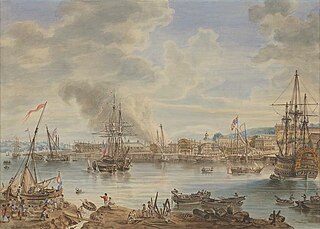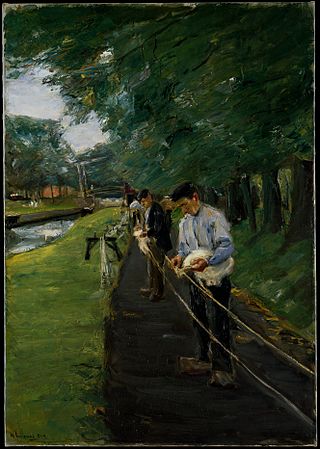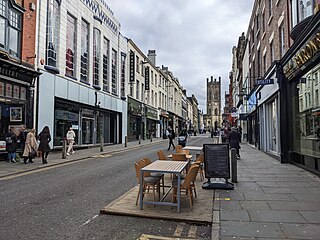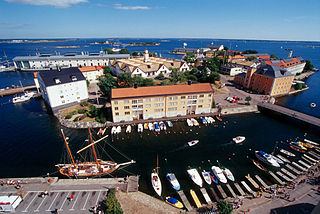
The Swedish Navy is the maritime service branch of the Swedish Armed Forces. It is composed of surface and submarine naval units – the Fleet, formally sometimes referred to as the Royal Navy – as well as marine units, the Amphibious Corps.

A rope is a group of yarns, plies, fibres, or strands that are twisted or braided together into a larger and stronger form. Ropes have tensile strength and so can be used for dragging and lifting. Rope is thicker and stronger than similarly constructed cord, string, and twine.

Chatham Dockyard was a Royal Navy Dockyard located on the River Medway in Kent. Established in Chatham in the mid-16th century, the dockyard subsequently expanded into neighbouring Gillingham; at its most extensive two-thirds of the dockyard lay in Gillingham, one-third in Chatham.

Karlshamn is a locality and the seat of Karlshamn Municipality in Blekinge County, Sweden. It had 13,576 inhabitants in 2015, out of 31,846 in the municipality.

Karlskrona is a locality and the seat of Karlskrona Municipality, Blekinge County, Sweden with a population of 66,675 in 2018. It is also the capital of Blekinge County. Karlskrona is known as Sweden's only baroque city and is host to Sweden's largest naval base and the headquarters of the Swedish Coast Guard.

HSwMS Gotland was an aircraft cruiser built for the Royal Swedish Navy during the 1930s. Completed in 1934, she was assigned to the Coastal Fleet and also served as a training ship for naval cadets in foreign waters until the beginning of World War II in 1939. During the war the ship conducted neutrality patrols and continued to serve as a training ship. Gotland was converted into an anti-aircraft cruiser in 1943–1944 as her floatplanes were obsolete and modern replacements could not be purchased. After the war ended in 1945, she became a dedicated training ship and resumed making lengthy foreign cruises with cadets.

A ropewalk is a long straight narrow lane, or a covered pathway, where long strands of material are laid before being twisted into rope. Due to the length of some ropewalks, workers may use bicycles to get from one end to the other.

HSwMS Carlskrona is the longest vessel in the Swedish Navy at 105.7 metres. Only Belos, the submarine rescue vessel, has a greater displacement. She was originally designed as a minelayer and is also used for exercise expeditions. She replaced HSwMS Älvsnabben in both roles.
The Mosaic Parish in Karlskrona, Mosaiska församlingen i Karlskrona, founded in 1785, was the fourth Jewish parish in Sweden. In 1994 it was placed in a resting mode.

The Parrett Iron Works was a series of industrial buildings next to the River Parrett, near Martock, Somerset, England.

The Karlskrona naval base is the largest naval base of the Swedish Navy. Located in Blekinge in southern Sweden, the base has close ties with the city of Karlskrona. It has an exceptionally well-sheltered location: arcs of islands provide a strong defense not only from the sea but also from land attacks. Two of Sweden's three naval warfare flotillas are based there. It contains the Marinmuseum and the Ropewalk, the longest wooden building in the country.

Ropewalks is a district of Liverpool city centre bounded by Hanover Street to the north-west, Lydia Ann Street to the west, Roscoe Street to the east and Back Bold Street to north-east.

Marinmuseum is a maritime museum located on Stumholmen island, in Karlskrona. It is Sweden's national naval museum, dedicated to the Swedish naval defense and preservation of the country's naval history.
A ropewalk is a long straight narrow lane, or a covered pathway, where long strands of material are laid before being twisted into rope.

Lindholmen is a small island to the immediate south of the city of Karlskrona in the south east of Sweden. Since the end of the 17th century, it has formed part of the Karlskrona Naval Base. It contains a number of facilities for the base including the Polhem Dock (Pohlhemsdockan) and the Ropewalk (Repslagarebanan).

Stumholmen is a small island to the east of Trossö in Karlskrona, Sweden. It is connected to the center of Karlskrona by the Bastionsgatan bridge. Formerly the property of the Navy, today it houses the National Naval Museum (Marinmuseum), one of Sweden's oldest founded in 1752, the Hyper Island educational complex, and several other historic buildings. The unusual Slup- och barkass- skjulet is noted for its remarkable roof while buildings on Laboratorieholmen once served as an isolation hospital when the town was struck with disease. Comprehensive restoration and renovation work has been undertaken since the 1990s, providing a variety of interesting sights for tourists as well as residential accommodation for senior citizens. Since 1998, the Naval City of Karlskrona, of which Stumholmen is a key component, has been a UNESCO World Heritage Site.

Applebyes Plads is a triangular area located between Langebro Bridge and the southernmost portion of Christianshavn Canal at the southern tip of the Christianshavn neighbourhood in Copenhagen, Denmark. The area takes its name from Peter Applebye, Christian VI's rope maker, who ran his manufactury from the site in the late 18th century, although no buildings remain from that time. The Danish Sugar Factories' building along the waterfront dates from 1912 while the rest of the grounds have undergone residential redevelopment in later years.

Polhemsdockan, the Polhem dry dock, is situated in the World heritage Örlogsstaden Karlskrona, was built in 1717–1724 and was the first dry dock in Sweden. It is cut out in the cliff on Lindholmen island and catered for shipping including the largest warships of its day.

HSwMS Karl XIV Johan was a ship of the line that served in the Swedish Navy and was built by Karlskrona Naval Shipyard. She was named after Karl XIV Johan. Commissioned in 1835 and decommissioned in 1867.

HSwMS Stockholm (P11) is a patrol vessel belonging to the Swedish Navy. Together with her sister ship HSwMS Malmö, she forms the Stockholm class. Stockholm was delivered on 1 March 1985 as the lead ship for a surface combat flotilla. In 2002, a mid-life upgrade was carried out and in 2010, Stockholm is included together with sister ship in the 31st Corvette Division in the 3rd Naval Warfare Flotilla. In 2016, Stockholm was rebuilt into a Malmö-class patrol vessel.
























